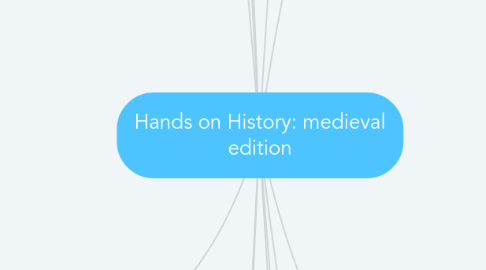
1. How is material animated? How to people get to touch books?
1.1. guiding questions for animators - teasing out information, engaging
1.1.1. what does this parchment feel like
1.1.2. what does a calendar do?
1.1.2.1. Days of the week
1.2. stations for question on one side/ answer on others
2. Games
2.1. Types
2.1.1. Clue
2.1.1.1. Did professor plum steal the mss
2.1.2. Scavenger Hunt
2.1.3. Treasure Hunt
2.1.4. Escape room
2.1.5. Timeline Card Game
2.1.6. Monopoly
2.1.6.1. Mss trade
2.1.7. Puzzles (online)
2.1.8. Murder mystery night
2.1.9. Where is Waldo mss search
2.2. Principles
2.2.1. competition
2.2.2. Fun
2.2.3. learning
2.2.4. solve mystery
2.3. Products
2.3.1. Clues
2.3.2. Scripts
2.3.3. Maps
2.3.4. Gameboard
2.3.5. Cards
3. People Involved
3.1. Audience
3.1.1. High school students/Undergrads
3.1.1.1. Limits on numbers?
3.1.1.1.1. 20?
3.2. Instructors/Aides
3.2.1. Larry (Master Printer)
3.2.2. Guest Speakers
3.2.3. In game speakers
3.2.4. Counsellors?
4. Work Teams
4.1. Social Media/Promotion
4.1.1. principles
4.1.1.1. entertaining
4.1.1.2. educating
4.1.1.3. driving people to somewhere else
4.1.2. Via
4.1.2.1. TikTok
4.1.2.1.1. Show activity in the book arts lab?? Making a quill? Doing calligraphy?
4.1.2.1.2. Turning the pages of a manuscript (for example: crazy plants in the botanical book that we saw in the first few weeks)
4.1.2.1.3. Show musical manuscripts with actual music of the period playing
4.1.2.2. Instagram
4.1.2.2.1. How many ways can you write the letter “a” in the middle ages?
4.1.2.2.2. Why the middle ages had more than one way to write the letter “s” Do you know what a “red letter” day is?
4.1.3. Tasks
4.1.3.1. Swag
4.1.3.1.1. Bookmark
4.1.3.2. Examples of promotional material
4.1.3.3. Timeline for promotional campaign
4.1.3.4. Make list of tasks
4.2. Gamification
4.2.1. Develop Gamified learning
4.2.1.1. Builds on displays and activities
4.2.2. Event Games
4.2.2.1. Amazing Race
4.2.2.2. Murder Mystery
4.2.2.2.1. 10-20
4.2.2.3. Trivia contest
4.2.2.3.1. Jeapardy?
4.2.2.3.2. Cahoots?
4.2.3. Display Games
4.2.3.1. Create a where's Waldo game just for display vistors
4.2.4. Make list of all possible tasks
4.3. Displays
4.3.1. What kind of display
4.3.1.1. Display in B.A.L
4.3.1.2. complementary to activities
4.3.2. Poster présentations
4.3.3. Behind glass displays?
4.3.4. Hands on display activities? Or is this a workshop?
4.3.5. Make list of all possible tasks
4.4. Big Picture
4.4.1. How can this be a template for other recruitment events.
4.4.2. What is the big picture?
4.4.3. Make list of roles/tasks
4.5. Workshops
4.5.1. How do workshops overlap with displays/ games
4.5.1.1. Yes
4.5.1.2. No
4.5.2. Make list of all possible tasks
4.5.2.1. Decide on workshops titles
4.5.2.2. Materials needed
5. Can we create games/ modules that would work for other classes?
6. Design principles
6.1. Fun
6.1.1. Fun for us
6.1.2. Fun for students
6.2. Manageable for us to complete before April 14
7. Big Idea:
7.1. Hands on History
7.2. How is information communicated
7.2.1. Today
7.2.2. Middle Ages
7.3. What do we want audience to learn?
7.3.1. Audience should come with a sense of the richness of the medieval book
7.3.1.1. "size matters"
7.3.1.2. materiality (big, heavy, colourful, boring)
7.3.1.2.1. what is available to be touched
7.3.1.3. foreignness and normalcy
7.3.1.3.1. calendar
7.3.1.3.2. size (what is a folio)
7.3.1.3.3. student notes and doodles
7.3.1.3.4. illustrated books vs modern picture books
7.3.1.3.5. technology of the book
7.3.2. Critical Questions
8. Location
8.1. Book Arts Lab
8.2. Paterson Hall
8.3. Campus
9. Workshops
9.1. Activities
9.1.1. Book binding
9.1.1.1. Demonstrations of basic book binding
9.1.1.1.1. If unable to make them individually, a general demonstration while working on own material
9.1.1.2. hands on making of own booklet
9.1.1.2.1. Cutting of paper, making of quire, threading together of booklets, mise en page (cover)
9.1.2. Ink/Script
9.1.2.1. practicing of script on scrap
9.1.2.2. comparisons between india ink and modern ink
9.1.2.3. demonstrations of different scripts
9.1.2.3.1. sheets with script refrence
9.1.3. Illuminations
9.1.3.1. Tracing of historiated letters onto their own booklet
9.1.3.2. demonstrations of coloured inks, how they were made (?), different kinds of art
9.1.3.2.1. Use of Greens | Teaching Manuscripts
9.2. Schedule
9.2.1. One workshop, 3 days
9.2.1.1. 1 1/2 - 2 hours (length of movie=length of attention span)
9.3. Materials
9.3.1. Paper
9.3.1.1. Plain
9.3.1.1.1. The cover would be plain and then decorated with illuminations
9.3.1.2. Templates for illumination (historiated letters, marginalia, etc)
9.3.1.3. Vellum?
9.3.2. Ink
9.3.2.1. India
9.3.2.2. Modern ink
9.3.2.3. Coloured Ink
9.3.3. Instruments
9.3.3.1. Awls
9.3.3.2. Needles and Thread
9.3.3.3. Quills/Fountain
9.3.3.3.1. Pre-made quills, or demonstrations as to how one was made
9.3.3.4. rulers
9.3.3.5. scissors/knives
9.4. Demonstrations
9.4.1. Book Binding
9.4.2. Script
9.4.3. Different kinds of illumination
9.5. Budget & Planning
9.5.1. Materials
9.5.1.1. vellum
9.5.1.2. ink
9.5.1.3. feathers
9.5.1.4. paper
9.5.1.5. fountain pens
9.5.1.6. Awls
9.5.1.7. pencils
9.5.1.8. exacto knives
9.5.2. Who would be running it
9.5.2.1. Larry?
9.5.2.2. Volunteers between class
9.5.2.3. Marc
9.5.2.4. MA students
10. Modules
10.1. What modules can be developed that can be used by different teams in their work.
10.1.1. Themes
10.1.1.1. continuity/ rupture
10.1.1.2. relevance
10.1.1.2.1. Material culture and design
10.1.1.2.2. how do you consume information
10.1.1.3. Communication strategies
10.1.1.3.1. weird but true
10.1.1.3.2. Mythbusting/ "Did you know"
10.1.1.3.3. I like big books
10.1.2. Think of modules as templates that can tie different materials together
10.2. Topics
10.2.1. navigating online repositories
10.2.2. handling delicate materials
10.2.3. politics of preservation
11. Goals
11.1. recruit
11.1.1. treat students as people
11.1.1.1. touch mss; not behind glass
11.1.2. showcase Carleton's resources
11.1.3. challenge assumptions about Carleton (i.e. that it CAN be a place to do MEMS stuff)
11.2. entertain
11.3. educate
11.3.1. What is history
11.3.2. What is public history
11.4. engage
11.4.1. accessibility
11.4.1.1. online/in-person
12. Work
12.1. Materials needed
12.1.1. Compile list of necessary materials
12.1.1.1. Bird feathers
12.1.1.2. Ink etc
12.1.1.3. Costumes for murder mystery
12.1.2. Digital materials
12.1.2.1. Website
12.1.2.2. Digital images
12.2. Schedule
12.2.1. Day 1
12.2.2. Day 2
12.2.3. Day 3
12.2.4. Decide upon the typical schedule for activities each day?
12.3. Budget
12.4. Products
12.4.1. What will we produce to showcase possibilities
12.4.1.1. Bookmarks for swag
